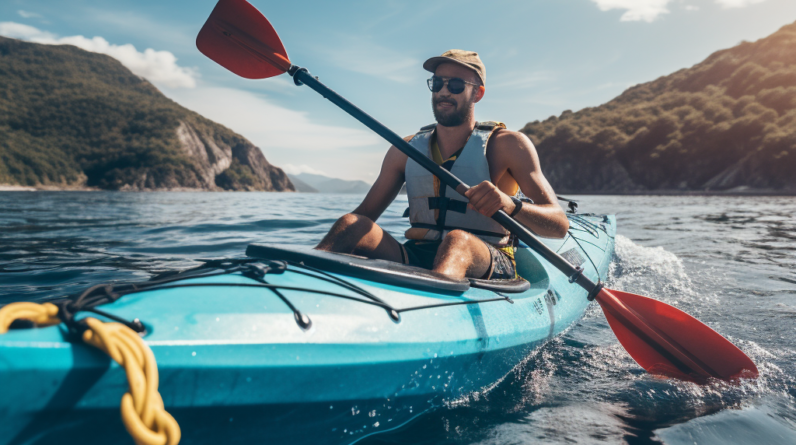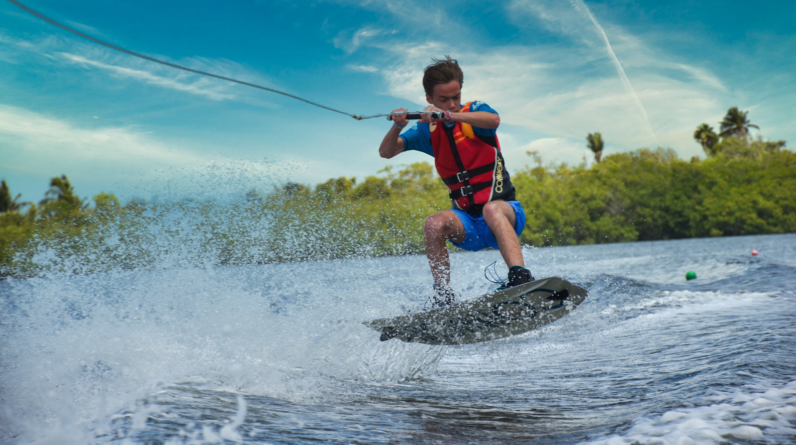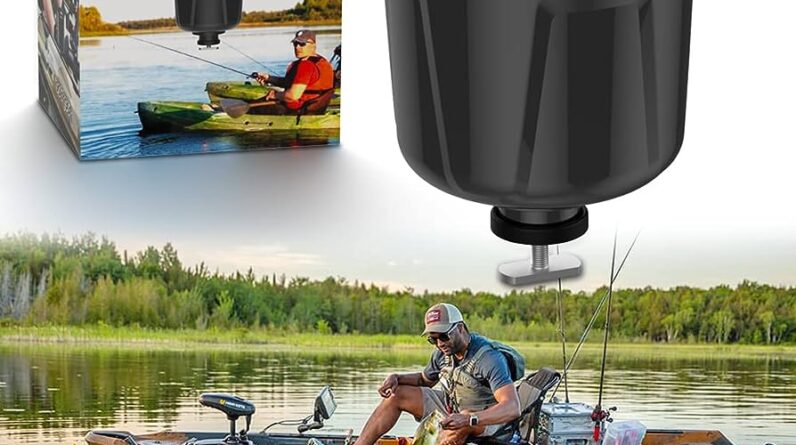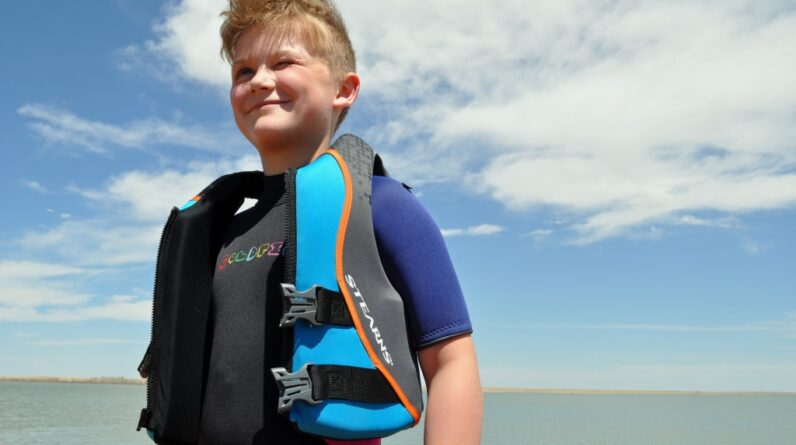
Are you planning a fun-filled adventure on the water with your little ones? Before you hit the waves, it’s crucial to ensure their safety by selecting the right water ski vests for children. With so many options available, it can be overwhelming to know where to start. In this ultimate guide, we will walk you through the process of choosing the perfect size and style of water ski vests, making sure your children are protected and comfortable as they experience the thrill of water skiing.
1. Understanding the importance of water ski vests for children
1.1 Ensuring safety while water skiing
Water skiing can be an exhilarating and fun activity for children, but safety should always be the top priority. When it comes to water skiing, wearing a proper fitting and appropriate vest is crucial for the safety of your child. Water ski vests are specifically designed to provide buoyancy and support in case of falls or accidents on the water. They help to keep your child afloat and reduce the risk of injury or drowning.
1.2 Legal requirements for wearing water ski vests
In many jurisdictions, including the United States, there are legal requirements for wearing water ski vests while participating in water sports activities. These regulations are put in place to ensure the safety of individuals, especially children, who are more vulnerable to accidents and injuries. It is important to familiarize yourself with the specific laws and regulations of your area regarding water ski vests for children to avoid any legal consequences and, most importantly, to prioritize the safety of your child.
2. Factors to consider when selecting water ski vests for children
Choosing the right water ski vest for your child involves considering several important factors:
2.1 Child’s age and weight
The age and weight of your child are essential considerations when selecting a water ski vest. Different vests are designed to provide proper buoyancy and support based on the child’s size and weight. It is crucial to choose a vest that is appropriate for your child’s age and weight to ensure a proper fit and maximum safety while water skiing.
2.2 Type of water skiing activities
The type of water skiing activities your child will be participating in is another crucial factor to consider. There are different types of vests designed for specific water sports, such as skiing, wakeboarding, or tubing. Each activity may require a different level of buoyancy and mobility, so it’s important to choose a vest that is suitable for the specific activity your child will be engaging in.
2.3 Buoyancy and flotation capabilities
The buoyancy and flotation capabilities of a water ski vest are key factors in ensuring the safety of your child. The vest should provide enough buoyancy to keep your child afloat and support his or her body in the water. It’s important to look for vests that are specifically designed for water skiing and provide adequate flotation to minimize the risk of submerging or sinking.
2.4 Size and adjustability
Proper sizing and adjustability are crucial when choosing a water ski vest for your child. The vest should fit snugly but comfortably, allowing for easy movement and range of motion. Look for vests with adjustable straps and buckles that can be tightened or loosened to achieve a secure and personalized fit for your child.
2.5 Material and durability
Water ski vests for children should be made of high-quality materials that are durable and resistant to wear and tear. The vest should be able to withstand the harsh conditions of water sports activities, such as exposure to sun, water, and frequent movement. Look for vests made from robust materials that are designed to last.
2.6 Comfort and range of motion
Comfort is an essential aspect of any water ski vest, especially for children. The vest should have soft padding and be comfortable to wear for extended periods. Additionally, it should allow for a wide range of motion to enable your child to move freely and comfortably while skiing. Look for vests that are designed with comfort and flexibility in mind.
2.7 Visibility and color
Visibility is an important safety feature to consider when selecting a water ski vest for your child. Choose vests in bright, vibrant colors that are easily visible on the water. Bold colors such as orange, yellow, or neon green are highly recommended as they make it easier for others to spot your child in the water in case of an emergency.
2.8 US Coast Guard approval
When choosing a water ski vest for your child, it is essential to look for US Coast Guard (USCG) approval. The USCG approval ensures that the vest meets specific safety standards and regulations set by the Coast Guard. Vests with USCG approval are tested and proven to provide adequate buoyancy and safety features, giving you peace of mind that your child is protected while on the water.
2.9 Cost and budget considerations
Cost is a practical factor to consider when selecting a water ski vest for your child. It’s important to set a realistic budget and explore options within that range. Remember, the safety and well-being of your child should always come first, so try to find a balance between cost and quality when making your selection.
2.10 Brand reputation and customer reviews
Considering the reputation of the brand and reading customer reviews can greatly assist you in choosing the right water ski vest for your child. Reputable brands often have a track record of producing high-quality and reliable vests. Customer reviews can provide insights into the actual performance, durability, and overall satisfaction of the product, helping you make a well-informed decision.

This image is property of cdn.watersportsoutlet.com.
3. Types of water ski vests suitable for children
There are several types of water ski vests available for children, each designed for different purposes:
3.1 Type I: Offshore Life Jackets
Type I vests, also known as offshore life jackets, are the most buoyant vests designed to turn an unconscious person face-up in the water. These vests are typically recommended for deep water activities and are suitable for children who may be participating in water skiing in open waters, such as lakes or oceans.
3.2 Type II: Nearshore Buoyant Vests
Type II vests, known as nearshore buoyant vests, offer slightly less buoyancy than Type I vests. They are designed for calm or nearshore waters where a quick rescue is expected. These vests are suitable for children participating in water skiing activities in relatively calm waters, such as ponds or slow-moving rivers.
3.3 Type III: Flotation Aids
Type III vests, also known as flotation aids, provide good buoyancy and are designed for conscious individuals who can actively participate in their own rescue. These vests are commonly used for water skiing activities as they offer a good balance between buoyancy and freedom of movement.
3.4 Type IV: Throwable Devices
Type IV vests are throwable devices, such as cushions or rings, that are intended to be thrown to a person in distress. They are not designed to be worn, but having one on board a boat during water skiing activities is a safety requirement. These devices can be a valuable backup in case of an emergency.
3.5 Type V: Special Use Devices
Type V vests are specialized for specific water sports activities, such as water skiing. They provide excellent buoyancy and are designed to accommodate the unique needs and movements associated with the specific sport. These vests often come with additional features, such as harnesses or impact protection, ensuring maximum safety and comfort for your child while on the water.
4. Sizing water ski vests for children
Proper sizing is crucial to ensure the effectiveness and safety of a water ski vest for your child. Here are some guidelines for sizing water ski vests:
4.1 Measuring a child’s chest size
To determine the appropriate vest size for your child, start by measuring their chest size using a soft tape measure. Wrap the tape measure around the widest part of their chest, typically just below the armpits. Ensure the tape measure is snug but not too tight. Note down the measurement in inches or centimeters, as this will help you compare it with the manufacturer’s size chart.
4.2 Choosing a vest size based on weight
In addition to chest size, some vests may also provide weight recommendations. It’s important to consider your child’s weight along with their chest measurement when selecting a vest size. Follow the manufacturer’s size chart, which will typically suggest a vest size range based on both chest size and weight.
4.3 Evaluating the manufacturer’s size charts
Every brand and manufacturer may have slightly different sizing guidelines, so it’s essential to consult their size chart for accurate measurements. Compare your child’s chest size and weight with the measurements provided by the manufacturer to determine the most suitable size for your child. Remember to also consider the adjustability of the vest, as this can further customize the fit and accommodate slight variations in measurements.

This image is property of h9t5q6g2.stackpathcdn.com.
5. Different styles of water ski vests for children
Water ski vests come in various styles, each offering different features and benefits. Here are some commonly available styles:
5.1 Full-Body Vests
Full-body vests provide comprehensive coverage and support for your child’s entire torso, including the chest, back, and sides. These vests offer maximum buoyancy and protection, making them suitable for children who are beginners, younger, or less confident in the water. Full-body vests tend to have multiple adjustable straps and buckles, allowing for a secure and personalized fit.
5.2 Front-Entry Vests
Front-entry vests, as the name suggests, are worn by slipping them on from the front of the body. These vests typically have a zipper or multiple buckles in the front, making them easy to put on and take off. Front-entry vests are popular among children as they offer a secure fit and are comfortable to wear during water skiing activities.
5.3 Side-Entry Vests
Side-entry vests are designed with entry points on either side of the vest. They are worn by slipping the vest over the head and securing the side buckles or straps. These vests provide a comfortable and secure fit, and many children find them easier to put on and take off compared to other styles.
5.4 Back-Entry Vests
Back-entry vests have a single entry point at the back, typically with a zipper or a large opening secured by straps or buckles. These vests are easy to put on and take off, making them a popular choice for children who prefer simplicity and convenience. Back-entry vests may offer a slightly less adjustable fit compared to front or side-entry vests.
5.5 Hybrid Vests
Hybrid vests combine features from various styles, offering a versatile and customizable option for children. These vests may have a combination of front, side, and back-entry points, providing flexibility and ensuring a secure fit. Hybrid vests are designed to cater to individual preferences and may be better suited for children who have specific requirements or preferences for comfort and fit.
6. Additional features to look for in water ski vests for children
In addition to the basic considerations, there are several additional features that you may want to look for in a water ski vest for your child:
6.1 Crotch straps and leg loops
Crotch straps and leg loops are additional security features that help prevent the vest from riding up or slipping off in the water. These straps or loops secure the vest between the legs, keeping it in place even during more active water skiing movements. They provide extra stability and help ensure that the vest remains properly positioned on your child’s body.
6.2 Adjustable buckles and straps
Look for water ski vests with adjustable buckles and straps to provide a customized fit for your child. Adjustable features allow you to tighten or loosen the vest as needed, ensuring a snug but comfortable fit. These features also allow for potential growth or weight fluctuations, allowing the vest to be adjusted over time.
6.3 D-rings and pockets
D-rings and pockets on water ski vests offer added convenience and functionality. D-rings can be used to attach accessories or equipment, such as a whistle or waterproof pouch for small belongings. Pockets provide storage for small items like keys, identification, or a snack. These features keep essentials within easy reach, making the water skiing experience more enjoyable and organized.
6.4 Whistles and reflective strips
Some water ski vests come equipped with whistles and reflective strips for enhanced safety. A whistle can be a valuable tool in emergencies to attract attention and communicate distress signals. Reflective strips increase visibility, especially in low light conditions, making it easier for others to spot your child in the water.
6.5 Drainage and drying capabilities
Water ski vests are likely to get wet and should have adequate drainage and drying capabilities. Look for vests that have drainage holes or mesh panels to allow water to quickly drain out, reducing the weight of the vest. Additionally, consider materials that dry quickly, ensuring that the vest is ready for use during subsequent water skiing sessions.
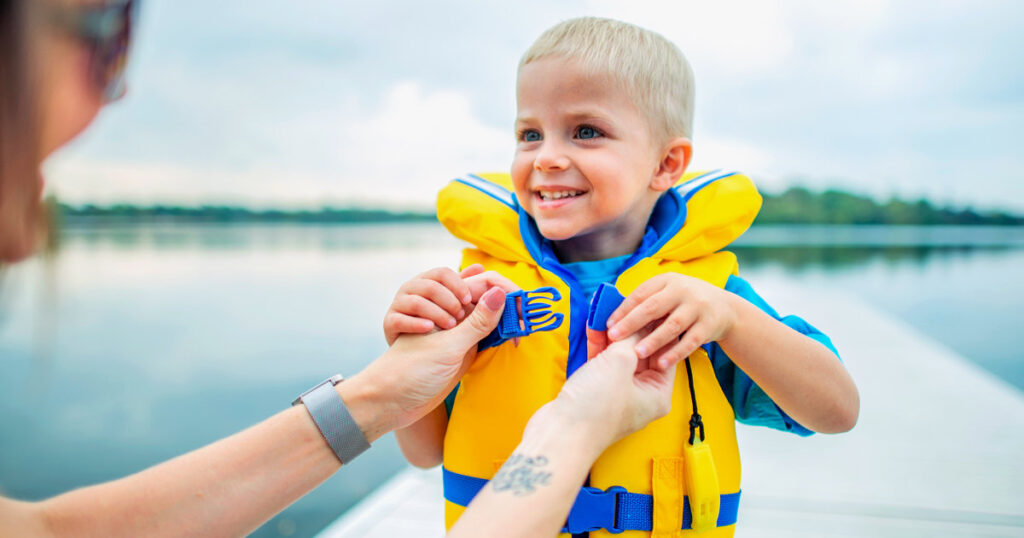
This image is property of media-cldnry.s-nbcnews.com.
7. Proper fitting and adjustment of water ski vests for children
A properly fitting and adjusted water ski vest is crucial for your child’s safety and comfort. Here are some important considerations when fitting and adjusting the vest:
7.1 Ensuring a snug but comfortable fit
The water ski vest should fit snugly but comfortably on your child’s body. It shouldn’t be too loose or too tight. A loose vest may impede mobility and may not provide adequate buoyancy, while a tight vest may restrict movement and cause discomfort. It’s important to find the right balance to ensure both safety and comfort.
7.2 Adjusting straps and buckles
Start by securing the main closure, whether it’s a zipper, front buckle, or back closure. Adjust the straps and buckles as needed to achieve a secure fit. Straps and buckles should be tightened enough to prevent the vest from riding up or shifting during water skiing, but not so tight that they cause discomfort or restrict movement.
7.3 Testing range of motion and mobility
Once the vest is securely fastened, have your child move their arms and torso to ensure they have a full range of motion and mobility. Encourage them to simulate the movements they would make while water skiing, such as reaching for the ski rope or bending down to grab the ski handles. The vest should allow for these movements without restriction or discomfort.
8. Maintaining and caring for water ski vests for children
Proper maintenance and care can prolong the life of your child’s water ski vest and ensure its effectiveness and safety. Here are some tips for maintaining and caring for the vest:
8.1 Proper cleaning and drying techniques
Cleaning your child’s water ski vest regularly is important to remove any dirt, sweat, or saltwater residue that may accumulate. Follow the manufacturer’s instructions for cleaning, as different materials may require specific cleaning methods. Always make sure the vest is fully dry before storing it, as dampness can lead to mold and mildew growth.
8.2 Inspecting for wear and tear
Regularly inspect your child’s water ski vest for any signs of wear and tear. Check for loose stitching, fraying fabric, or damaged buckles. Make sure the zippers are fully functional and examine the straps for any signs of weakening or stretching. If you notice any significant damage or deterioration, it may be time to replace the vest to ensure continued safety.
8.3 Storing the vests properly
When not in use, store water ski vests in a cool and dry place, away from direct sunlight or extreme temperatures. Avoid folding or compressing the vest too tightly, as this can lead to creases or damage to the material. Hanging the vest or placing it on a flat surface is generally recommended to maintain its shape and integrity.

This image is property of cdn.wetsuitoutlet.co.uk.
9. Evaluating the US Coast Guard approval for water ski vests
US Coast Guard (USCG) approval is an important factor to consider when selecting a water ski vest for your child. Here’s what you need to know about USCG approval:
9.1 Understanding USCG labeling requirements
To receive USCG approval, water ski vests must meet specific safety standards and regulations set by the Coast Guard. Look for vests with visible labeling indicating their USCG approval. These labels typically provide information about the type of vest, the intended use, and any specific size or weight restrictions.
9.2 Checking for the USCG approval number
In addition to the label, check for the USCG approval number on the vest. This number indicates that the vest has been tested and meets the required safety standards. You can cross-reference this number with the US Coast Guard’s database to ensure the validity of the approval. Verifying the USCG approval ensures that you are purchasing a vest that meets the necessary safety standards and regulations.
10. Comparing different brands and reading customer reviews
When selecting a water ski vest for your child, it’s essential to consider different brands and read customer reviews to make an informed decision. Here’s why it matters:
10.1 Researching reputable brands
Researching and choosing reputable brands can provide assurance of the quality and durability of the water ski vest. Reputable brands often have a history of producing reliable and high-performance gear. Look for brands that specialize in water sports equipment, as they are more likely to have specific expertise and knowledge in designing and manufacturing water ski vests.
10.2 Reading customer feedback and reviews
Reading customer feedback and reviews can provide valuable insights into the actual performance and durability of water ski vests. Customers who have purchased and used the vests can share their experiences and opinions, giving you a better understanding of the pros and cons of each product. Pay attention to feedback related to fit, comfort, durability, and overall satisfaction to make an informed decision.
By considering the factors outlined in this guide, you can confidently select the right size and style of water ski vest for your child. Prioritizing safety, comfort, and quality will ensure that your child’s water skiing experience is not only enjoyable but also safe and secure. Remember, a well-fitting and appropriate water ski vest is an investment in your child’s safety on the water.

This image is property of images.squarespace-cdn.com.

